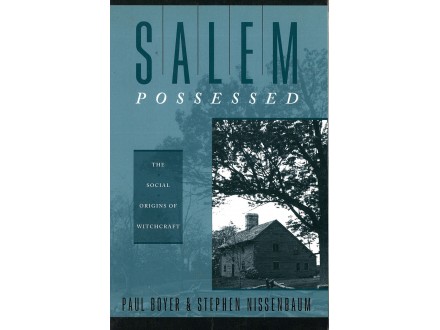SALEM POSSESSED - THE SOCIAL ORIGINS OF WITCHCRAFT
| Cena: |
| Želi ovaj predmet: | 5 |
| Stanje: | Nekorišćen |
| Garancija: | Ne |
| Isporuka: | Pošta Lično preuzimanje |
| Plaćanje: | Tekući račun (pre slanja)
Lično |
| Grad: |
Novi Sad, Novi Sad |
Godina izdanja: 2001
ISBN: 978-0674785267
Jezik: Engleski
Autor: Strani
Salem Possessed: The Social Origins of Witchcraft Reprint Edition
by Paul Boyer (Author), Stephen Nissenbaum (Author)
Product details
Item Weight: 8.1 ounces
Paperback: 231 pages
Dimensions : 5.4 x 0.8 x 8.2 inches
Publisher: Harvard University Press; Reprint edition (February 1, 1974)
Language: English
“An illuminating and imaginative interpretation…of the social and moral state of Salem village in 1692. Provides an admirable illustration of the general rule that, in Old and New England alike, much of the best sociological history of the twentieth century has only been made possible by the antiquarian and genealogical interests of the nineteenth… This sensitive, intelligent, and well-written book will certainly revive interest in the terrible happenings at Salem.”―Keith Thomas, New York Review of Books
“A provocative book. Drawing upon an impressive range of unpublished local sources, Paul Boyer and Stephen Nissenbaum provide a challenging new interpretation of the outbreak of witchcraft in Salem Village. They argue that previous historians erroneously divorced the tragic events of 1692 from the long-term development of the village and therefore failed to realize that the witch trials were simply one particularly violent chapter in a series of local controversies dating back to the 1660s. In their reconstruction of the socio-economic conditions that contributed to the intense factionalism in Salem Village, Boyer and Nissenbaum have made a major contribution to the social history of colonial New England… [They] have provided us with a first-rate discussion of factionalism in a seventeenth-century New England community. Their handling of economic, familial, and spatial relationships within Salem Village is both sophisticated and imaginative.”―T. H. Breen, William and Mary Quarterly
“This is an ‘inner history’ of Salem Village that aims to raise the events of 1692 from melodrama to tragedy… It is a large achievement. This book is progressive history at its best, with brilliant insights, well-organized evidence, maps, and footnotes at the bottom of the page.”―Cedric B. Cowing, American Historical Review
“The authors’ whole approach to the Salem disaster is canny, rewarding, and sure to fascinate readers interested in that aberrant affair.”―The Atlantic
“This short book is a solid contribution to the understanding of the 1692 witch trials. The authors use impressively rich demographic detail to support the thesis that the witch trials are best explained as symptoms of typical social tensions in provincial towns at the time. According to Boyer and Nissenbaum, Salem villagers played roles determined by economic, geographic, and status interests.”―Richard Ekman, Canadian Historical Review
“An important, imaginative book that brings new insights to the study of the 1692 witchcraft outbreak in Massachusetts. Building on Charles Upham’s Salem Witchcraft (1867), Boyer and Nissenbaum explore decades of community tension and conflict in order to explain why Salem was the focus of this episode. The authors reveal a complex set of relationships between pers
KC
Predmet: 63965805









